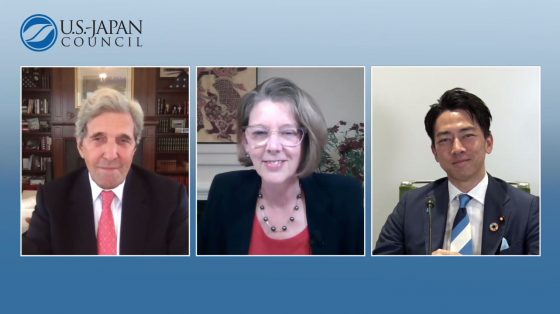This article is part of a series of insights and essays from members in our community. If you would like to submit an article or recommend a USJC member to be featured, please click here.
Insights from Yasuo Tanabe, Senior Advisor, U.S.-Japan Council; Councilor, The Institute of Energy Economics, Japan; Managing Director, EU-Japan Centre for Industrial Cooperation

From my perspective, the Bilateral Boardroom talk with two global leaders for climate action, John Kerry and Koizumi Shinjiro, was filled with important statements and implications for climate/energy watchers. Here are some of my key takeaways, starting with comments made by U.S. Special Presidential Envoy for Climate John Kerry.
First, Kerry “bluntly” – as he put it – explained that Japan is a critical climate leader because Asia needs to transition faster from its dependency on fossil fuel and coal. He expects Japan’s influence with other Asian countries to spur the region into leapfrogging where it is today in the energy transition. I believe the U.S. and Japan should closely communicate on how Asia, with help of the U.S. and Japan, can make this transition effectively, i.e., supplying energy sufficiently and affordably.
Second, Kerry noted that fossil fuel is fine – that is, if you can capture 100% of CO2, and he did not exclude the option of Carbon Capture, Usage and Storage (CCUS). Kerry went on to say that global natural gas production with leakage of methane has made us “our own worst enemy.” This means that countries dependent on fossil fuels face a big challenge in determining how to shift to carbon-free energy as well as how to control methane leakage and economically implement CCUS.
Third, when asked about U.S.-China climate cooperation, Kerry stressed that it is up to the Chinese leadership to take steps that are doable. Kerry mentioned changes in fossil-fuel-based power generation and in the cement and steel industries need to be tackled with U.S.-China cooperation on capturing or abating emissions. He urged China to do more, saying that China has the ability to take bigger steps and that China’s anticipation of reaching peak emissions in 2030 is too late. Interestingly, if China does not do enough, Kerry suggested there could be other problems with many countries looking at Carbon Border Adjustment Mechanisms (CBAM) – “different ways of dividing up the global economy.” Kerry does not seem to like the EU’s idea of CBAM.
Fourth, I personally liked Kerry talking about the important role of technology, such as nuclear technology, i.e., small modular reactor (SMR) and grid technology, which can connect New York and California or the U.S., Mexico and Canada, thereby balancing changing/intermittent demand and supply of renewables. I hope that many of Kerry’s observations resonate with Koizumi.
As for comments made by Japan’s Minister of the Environment, first, Koizumi justifiably boasted that the country has made Prime Minister Suga’s commitment of carbon neutrality by 2050 into binding law, driven by a consensus between the ruling and opposition parties. With this action, Japan has joined Europe, obliging it through a national consensus to the 2050 carbon neutrality goal. The U.S. does not have such a consensus, although the Biden administration strongly commits to the goal. I am curious how Kerry views this. Is he envious of Japan’s political sentiment? Does he think that the Biden administration has to work hard to reach a national consensus of decarbonization?
Second, Koizumi correctly pointed out the importance of Article 6 of the Paris Agreement: Market Mechanism. The Kyoto Protocol had introduced the Clean Development Mechanism (CDM) in which “Developed Country A” provides emission-reduction technology to “Developing Country B” and can gain credits, thereby promoting international cooperation to reduce global emissions. But this is no longer in practice because of difficulties with verification and procedure. Many experts say this kind of market mechanism or offset mechanism would be effective in reducing global emissions. The current Article 6 of the Paris Agreement stipulates it, but its rule books have to be worked out and agreed to at the COP26, the 26th United Nations Climate Change Conference in Glasgow in November. If the schemes are agreed upon, this mechanism will accelerate international cooperation for global emission reduction.
Third, Koizumi discussed a “decarbonization domino” from within Japan to other countries in the Asia-Pacific region, citing the case of the Tokyo-Kuala Lumpur partnership for 2050 carbon neutrality. Koizumi, as environment minister, is wise to keep an eye on local endeavors and then expand them overseas since he cannot intervene in domestic energy policy, which is under the jurisdiction of Japan’s Ministry of Economy, Trade and Industry (METI). The carbon neutrality goal cannot be achieved by energy businesses and industries alone, but needs local actions and individual efforts, and must be reflected in global perspectives.
As a leader for Japan with an international orientation, Koizumi is continuing to gain additional political skills. These skills will be put to the test and are needed to make meaningful progress on climate actions globally.
–Yasuo Tanabe, Senior Advisor, U.S.-Japan Council;
Councilor, The Institute of Energy Economics, Japan;
Managing Director, EU-Japan Centre for Industrial Cooperation